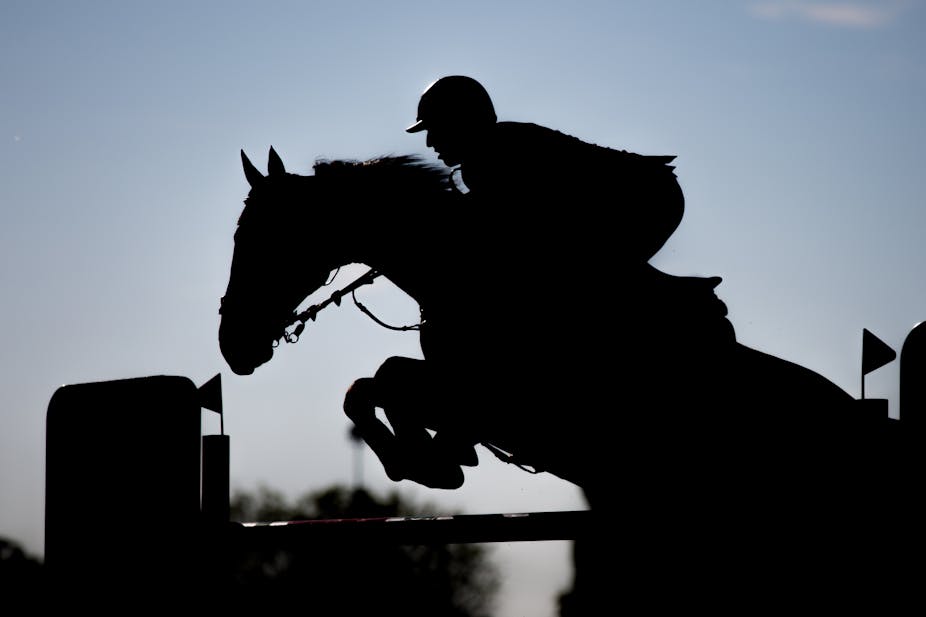In 2008, the president of the International Equestrian Federation (FEI), Princess Haya Bint Al Hussein, warned that equestrian sports might not make it into the London 2012 Games. She was wrong, but at that Olympics, equestrian eventing was described as perhaps the most dangerous sport at the Olympics.
Eventing, in which a single horse and rider compete across the three disciplines of dressage, cross-country, and show jumping, is dangerous without doubt. A review of the London 2012 competition concluded that all horses and riders which had fallen were “fine”. Being “fine” included one rider being hospitalised with concussion and a sacral fracture, one horse being sent for veterinary observation for bruises to the ribs and chest and another being retired from competition following a tendon injury.
Despite ongoing safety concerns, equestrian sport is one of the 25 core sports recommended for inclusion in the 2020 Games. But there should be no debate about the need to improve its safety. Alarm bells rang in 1999 when five event riders in the UK and one in the US died following falls at jumps.
The horse hitting the fence, somersaulting, throwing the rider out of the saddle and subsequently landing on the rider, caused five out of these six deaths and this type of fall – known as “rotational fall” – and it continues to be the main cause of human fatalities in eventing.
Following the tragedies in 1999 the International Eventing Safety Committee was formed. Their recommendations stated simply that “everything possible should be done to prevent horses from falling”. Unlike show jumps, most cross-country fences are solid and one recommendation was that jumps should be collapsible if hit hard by the horse.
The use of collapsible fences has probably saved a number of horses and riders from serious injury or death. For example, in 2014, nine fences on the Mitsubishi Motors Badminton course were fitted with frangible (breakable) pins, allowing them to collapse on impact - which they did. Safety concerns feature heavily in course design and building fences that are less risky is vital to improve both human safety and horse welfare.
Since 2006 British Eventing has required frangible pins to be used on as many jumps as possible but in FEI eventing their use is at the discretion of the course designer. It will be interesting to see how many collapsible cross-country jumps French course designer Pierre Michelet includes at Rio.
Sadly, 15 years after the first commissioned safety report, fatalities in eventing continue. Since 2013, there have been ten fatalities across the world, with three occurring between March and May 2016. Although solid fences remain an issue, making fences collapsible does not stop horses from falling.
An FEI audit into risk factors found that fences with frangible pins were associated with an increased risk of falls. It also found, unsurprisingly, that less experienced riders were at greater risk of falling and that certain jumps, including downhill fences and water jumps, caused problems.

Leading a horse to safety
One of the most important factors in clearing a jump successfully is the rider’s ability to judge where to take off, how high to jump and how to land safely. Eye-tracking footage collected from Olympic show-jump rider Tim Stockdale demonstrates how maintaining a steady point of gaze on the approach to a jump is one of the skills of an elite rider.
On the final page of the FEI cross-country course design guidelines is a list of points to consider “from the horse’s perspective”. “Risky” jumps may in fact be hard for the horse to see clearly. For example, the reflective layer at the back of the horse’s eye will increase the dazzle effect of water. As noted in our comparative review of horse and human vision, some fence designs may challenge not only the athletic skills of the event horse but also the visual judgement of the animal, which has safety implications for both horse and rider.
Perhaps the most important point to consider is that the horses do not get to walk the course and have to judge how to jump obstacles at speed based on the information in front of them. So will eventing remain an Olympic sport past 2020? Olympic rider and coach Jim Wofford has pointed out that we need an event “designed by humans for horses”. The review of jump design from the point of view of the horse is paramount, as is improving the skills of their riders. Let’s hope Rio 2016 turns out to be a showcase event for safe eventing.

